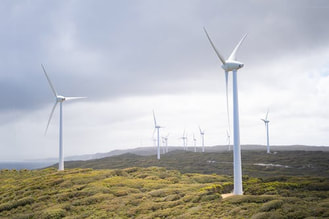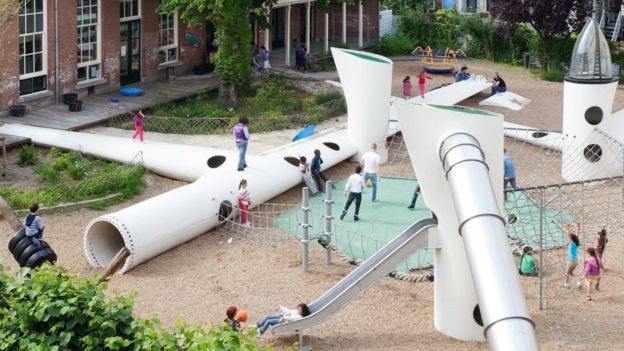|
When wind turbine blades reach the end of their working lives at about age 25, they can sometimes find a second life. If not, they may end up buried in the ground. Turbines from the 1990s wave of wind power are reaching the end of their life expectancy. About two gigawatts worth of turbines will be refitted in 2019 and 2020. And disposing of them in an environmentally-friendly way is a growing problem.
Plastic Pellets |
Today's turbine blades are built from composite materials - older blades from glass fibre, newer ones from carbon fibre. Such composite materials might be light and strong, but they are also extremely hard to recycle. That doesn't mean they have to go into landfill, according to Don Lilly, chief executive of Global Fiberglass Solutions in Bellevue, Washington. Mr. Lilly has been transforming fibreglass composites into small pellets he calls EcoPoly. The pellets can then be turned into injectable plastics, or highly waterproof boards that can be used in construction, he says. Mr. Lilly has received interest from "several manufacturers" for his pellets. He's also developed a programme to track blades throughout their life cycle, and make it easier to recycle them at the end.
Glue, Paint, Concrete, and Fertilizer
If we "holistically think about the end of life, there are simple choices we could make now that could make fibreglass in the blade easier to recycle," says Richard Cochrane, professor of renewable energy at Exeter University.
A second avenue for recycling turbine blades is called pyrolysis. After first chopping up the blades, pyrolysis breaks up the composite fibres in ovens with an inert atmosphere, at about 450-700C. The process recovers fibres other industries can reuse for glues, paints, and concrete. Other products include syngas (synthesis gas) that can be used in combustion engines. And char (charcoal) which can be used as a fertiliser.
The problem is significant amounts of energy are needed to activate the pyrolysis, which might limit its environmental usefulness. It has mainly been done at a laboratory scale. Germany's subsidiary of the French recycling group Veolia is researching the technology.
If we "holistically think about the end of life, there are simple choices we could make now that could make fibreglass in the blade easier to recycle," says Richard Cochrane, professor of renewable energy at Exeter University.
A second avenue for recycling turbine blades is called pyrolysis. After first chopping up the blades, pyrolysis breaks up the composite fibres in ovens with an inert atmosphere, at about 450-700C. The process recovers fibres other industries can reuse for glues, paints, and concrete. Other products include syngas (synthesis gas) that can be used in combustion engines. And char (charcoal) which can be used as a fertiliser.
The problem is significant amounts of energy are needed to activate the pyrolysis, which might limit its environmental usefulness. It has mainly been done at a laboratory scale. Germany's subsidiary of the French recycling group Veolia is researching the technology.
|
Slides and Seats
In Rotterdam unwanted blades have been put to a different use. The Dutch city boasts a 1,200sq m children's playground called Wikado, with a slide tower, tunnels, ramps, and slides all made from five discarded wind turbine blades. Decommissioned blades have also been turned into another playground and outdoor seats in the Dutch city of Terneuzen, two bus stops in Almere, a seat beside Rotterdam's famous Erasmusbrug bridge. Césare Peeren, an architect from Rotterdam's Superuse Studios is currently waiting for planning permission to turn two 55m blades into a bridge in Denmark's city of Ålborg, he says. |
Photo by Denis Guzzo
|
Bigger and Better
Meanwhile new rotors are only getting bigger. "Twenty years ago, my colleagues and I used to ask ourselves what is the most powerful offshore wind turbine that we could imagine," says Vincent Schellings, who works for General Electric in the Dutch city of Enschede. "We couldn't picture anything much more powerful than a three megawatt (MW) output, but even that seemed a challenge," he says.
Meanwhile new rotors are only getting bigger. "Twenty years ago, my colleagues and I used to ask ourselves what is the most powerful offshore wind turbine that we could imagine," says Vincent Schellings, who works for General Electric in the Dutch city of Enschede. "We couldn't picture anything much more powerful than a three megawatt (MW) output, but even that seemed a challenge," he says.
Mr. Schellings recently led the development team for GE's Haliade-X, now the world's largest wind turbine. It produces 12MW - four times the amount he imagined 20 years ago. Its 107m blades yield 45% more energy than previous offshore turbines. "So we are going to see much bigger turbines offshore in this decade, and the reason is size matters," says Rolf Kragelund, Danish-based director of offshore wind for the energy research firm Wood Mackenzie.
Bigger onshore turbines can access faster wind speeds, higher in the sky. They can produce more energy, meaning you need fewer of them, which saves money on transport, installation and servicing. Siemens Gamesa says 20 of its new 10MW turbines, announced last year with 94m blades, could power Liverpool, with a population of half a million.
Bigger onshore turbines can access faster wind speeds, higher in the sky. They can produce more energy, meaning you need fewer of them, which saves money on transport, installation and servicing. Siemens Gamesa says 20 of its new 10MW turbines, announced last year with 94m blades, could power Liverpool, with a population of half a million.
|
But large turbines bring along their own challenges, including what to do with them when they are no longer needed. Bigger blades "need bigger factories, bigger vessels, cables, foundations, and handling equipment," says Ray Thompson, global business development head at Spanish-headquartered Siemens Gamesa, one of the world's two largest wind turbine makers.
|
Longer blades can make for bigger recycling headaches...
|
Longer blades can make for bigger recycling headaches, too. The composite fibreglass in blades is "the most difficult, and the most expensive part" of turbines to recycle, Mr Kragelund says. And there's more of it. There's some reselling of second-hand turbine components from Europe to the Middle East and Asia pacific, he says. Big data, leading to better maintenance regimes and more reliable components could also mean today's blades might last longer, says Siemens's Mr Thompson. Recycling has made more progress so far in the onshore than offshore industry, which is newer, he adds. But while "there is work being done to find ways to recycle materials from old turbines," it "would be nice to see more design input now, so that's easier in the future," says Professor Cochrane.
This article was adapted from the BBC story, “What happens to all the old wind turbines?” See the original article.




